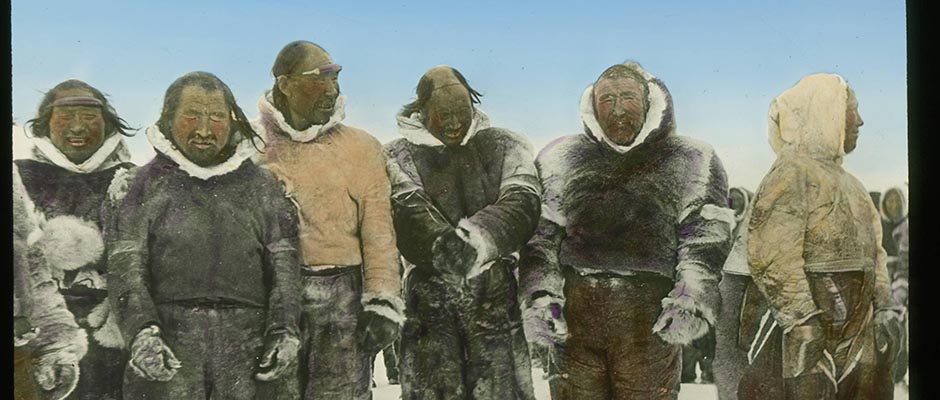-
George Mellis Douglas
Encyclopedia Arctica 15: Biographies
001 | Vol_XV-0273
EA-Biography
(Alyce Finnie)
GEORGE MELLIS DOUGLAS
George Mellis Douglas (1875 - 1963 ), engineer and explorer, was born
in Halifax, Nova Scotia, on December 9, the son of Campbell Mellis Douglas,
V.C., M.D., Col. R.A.M.S., and Eleanor Ann (Burmester) Douglas. He was
educated at the Grove School, Lakefield, Ontario, Trinity College School,
at Port Hope, Ontario, at Toronto University from 1892-93, and at Ruther–
ford College, Newcastle on Tyne, from 1894 to 1897, during which time he
was also apprenticed as engineer with the Armstrong and Hawthorn Leslie
Works. He went to sea as a marine engineer from 1897 to 1900, and then
began a career in Mexico and Arizona as an engineer and later consulting
engineer which lasted until 1940.This engineering career in the southwest was interrupted by the first
of Douglas' northern mineral explorations, his 1911-1912 journey to Great
Bear Lake to investigate the copper deposits of the Coppermine area. In
1771 Samuel Hearne attempted to find the "copper mines" reported long before
by the Indians. Hearne was unsuccess f ul in his attempts, though his Indian
guides pointed out to him the "jumble of rocks" containing the deposits.
In 1820 Sir John Franklin was instructed to observe the mineral occurrences
of the Coppermine Mountains and Dr. John Richardson, a member of the party
who possessed some geological knowledge, described the character of the
formation, but its extent was not determined. In 1836 Thomas Simpson reported
002 | Vol_XV-0274
EA-Biog. Finnie: George Mellis Douglas
finding copper in the Copper Mountains and at Bathurst Inlet, and similar
reports were made by David Hanbury in 1903.The next and most serious attempt to investigate these copper deposits
was made by the Douglas expedition in 1911, sponsored by Dr. James Douglas
of Arizona, and headed by George M. Douglas, his cousin. The party included
Lionel Douglas, brother of George, and Dr. August Sandberg, a geologist.They traveled by means of the Hudson's Bay Company's transport as far
as Fort Norman, then tracked up the Great Bear River to Great Bear Lake in
their York boat. They sailed across the lake to the northeast corner where
the Dease River flows into Great Bear Lake. Douglas and Sandberg canoed up
the Dease River to Dismal Lakes and thence by the Kendall River to the Copper–
mine. Investigations were made around the Coppermine Mountains during this
first season, before they returned to winter at their base on the Dease River.The next spring they returned to the Coppermine to continue their
investigations and found the extent of the mineralized area to be much greater
than had been supposed, the width of the belt being about sixteen miles. The
information brought back was considered important enough to continue more
extensive prospecting, but the first World War and its effect on the copper
industry discouraged further work in that region.In 1928, accompanied by Carl Lausen, a geologist, Douglas made a summer
journey with two canoes along the southeast shores of Great Slave Lake, on a
copper investigation for the United Verde Copper Company.In 1932 he made some coal investigations on the western shore of Great
Bear Lake, and in 1935 returned north to undertake mineral explorations around
Athabaska Lake and the country between it and Great Slave Lake; and on Great
Bear Lake. He continued his mineral explorations in 1938 with examinations
of the Snare River and the country between Great Slave Lake and Talston Lake,
003 | Vol_XV-0275
EA-Biog. Finnie: George Mellis Douglas
including Nonacho Lake.Douglas has been a true pioneer and explorer in the sense that he
opened up new vistas for mineral investigations by others, who, following
in his tracks, discovered important mineral deposits.He is the author of Lands Forlorn (G.P. Putnam's Sons, New York, 1914),
the story of his 1911-1912 expedition to the Coppermine River. For the
Canadian Mining and Metallurgical Bulletin , February 1929, he wrote an
account of his 1928 trip, "A Summer Journey along the Southeast Shores of
Great Slave Lake," and an article for the Engineering and Mining Journal Press ,
July 19, 1924, "Copper Deposits of Arctic Canada."Unpublished are detailed journals of all of his northern journeys,
illustrated with excellent photographs from his large personal collection.Douglas is a member of the American Society of Mechanical Engineers,
the American Institute of Mining and Metallurgical Engineers, the Canadian
Institute of Mining and Metallurgy, the Explorer's Club, New York, and the
Arts and Letters Club, Toronto. He is a Fellow of the American Geographical
Society and of the American Association for the Advancement of Science.Alyce Finnie

